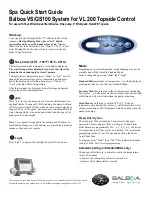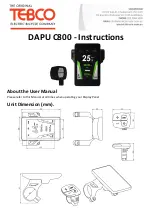
BrewBlast™ 70CPH O&M
South-Tek Systems
20
7
KEY CONTACTS
Contact your local provider/installer with any questions regarding the performance and/or maintenance of the
system. They will be best suited to answer your questions and should be readily available to help provide a
resolution to any issues you may have.
8
FAQS
8.1
POWER ISSUES
If the
BrewBlast™ 70CPH does not have power, the production and storage of nitrogen will become apparent once
the storage pressure drops. The taps will begin to pour slowly or not at all.
1.
Check the power cord
2.
Has the building’s circuit breaker or GFCI tripped? Locate the breaker and reset. If the breaker
continues to trip, the circuit may be overloaded.
8.2
PRESSURE ISSUES
If the gas blender is included, both gases (N
2
and CO
2
) will need available pressures over 40 psig. Blenders will
shut down output if either gas is not present over 40 psig.
The
BrewBlast™ 70CPH will produce and store nitrogen between 60-85 psig. Once the storage tank reaches 85
psig, the system will go into Stand-By Mode. When the pressure drops to 60 psig, the system should go into
Operation Mode and begin to refill the storage tank. If you are out of the specifications, we need to determine
where the issue is. Contact the manufacturer or a factory trained technician.
CO
2
Pressure Check:
If you have the blender option, check the CO
2
regulator pressure gauge. It should read between 80 and 100 psig. If
it is lower, check the CO
2
Storage tank to see if it needs refilling or if the pressure regulator needs adjustment. The
pressure going into the
BrewBlast™ 70CPH is recommended to be set at 85 psig.
Nitrogen Pressure Check:
Look at the pressure gauge on the top of the cabinet. It should be between 50 and 85 psig. If the pressure is low, a
couple things need to be checked:
Check the power.
Check for leaks throughout the system. Refer to section on
Pressure Regulation Check:
If the CO
2
and N
2
are both present and the blender is outputting gas, it is possible that a regulator is malfunctioning
or needs adjustment. The mixed gas coming from the blender should be between 40-85 psig (dependent on the N
2
and CO
2
pressures going into the blender). A primary regulator is usually installed on the output lines coming from
the
BrewBlast™ 70CPH. The primary regulator is there to “step down” the available pressure to the kegs. There are
typically secondary regulators located further downstream on the mixed gas lines going to the kegs. The secondary
regulators are there to individually tune each keg. Some coffees require more/less pressure and regulating each
keg individually will allow the coffee pouring to be optimized.
If the
BrewBlast™ 70CPH is operating correctly, then the establishment should contact their Draft Coffee System
Technician to adjust the regulators for optimal performance.
Summary of Contents for 70CPH
Page 4: ...BrewBlast 70CPH O M South Tek Systems 4 Notes...
Page 12: ...BrewBlast 70CPH O M South Tek Systems 12...
Page 13: ...BrewBlast 70CPH O M South Tek Systems 13 Optional Separate N2 Storage Tank Setup...
Page 19: ...BrewBlast 70CPH O M South Tek Systems 19...
Page 22: ...BrewBlast 70CPH O M South Tek Systems 22 Last Page...



































